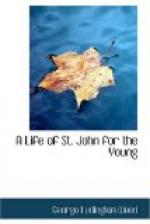“This beginning of miracles,” says John. What was this beginning? It was not the healing of the sick, nor raising of the dead, nor supplying a hungry company with bread, nor furnishing a necessary drink. There was no display. Jesus stretched forth no rod over the water-jars, as did Moses over the waters of the Nile when the same Divine power changed them into like color, but different substance, and with a different purpose. The first manifestation of His glory was for “the increase of innocent joy.”
When John had read the story of Jesus in the first three Gospels, and found no record of this miracle, did he not feel that there had been a great omission which he must supply? Nowhere else does Jesus appear just as He did at that feast, though other incidents of His life are in harmony with it. It is sometimes said He “graced” that marriage feast, as royalty does by mere presence. But He did more. He entered into the innocent festivities, and helped to their success. A glance into that village home is a revelation of Jesus in social life, and His interests in human friendships and relations.
We must remember that it was only innocent pleasures that He helped to increase, in which alone we can seek the presence of His Spirit, and on which alone we can ask His blessing.
This marriage feast must have been of special interest to John, if, as is supposed, the family was related to Mary and probably to him. This would seem to be her first meeting with Jesus since He bid her farewell in Nazareth, and left the home of thirty years, to be such no longer.
Did not Mary, mother-like, call John aside from the festive scene and say to him, “What has happened at the Jordan? tell me all about it.” I seem to hear John saying to her; “It is a wonderful story. Of some things I heard, and some I both saw and heard. You know of the ministry of your cousin Elizabeth’s son John—of his preaching and baptizing. Jesus was baptized by him. Immediately they both had a vision of ’the Spirit of God descending upon Him; and lo! a voice from heaven saying, This is My beloved Son.’ Then John was certain who Jesus was. He told the people about the vision, saying, ’I saw and bear record that this is the Son of God.’ And one day when my friend Andrew and I were with him, he pointed us to Jesus saying, ‘Behold the Lamb of God,’ whom we followed, first to His abode on the Jordan, and then here to Cana. We were disciples of John, but now are His disciples, and ever shall be. You know, aunt Mary, how from childhood I had thought of Him as my cousin Jesus, and loved Him for His goodness. From what my mother has told me, which she must have learned from you, there has been some beautiful mystery about Him. It is all explained now. Hereafter, I shall love Him more than ever, but I shall think of Him, not so much as my cousin Jesus, as the Messiah for whom we were looking, and as the Son of God.”




